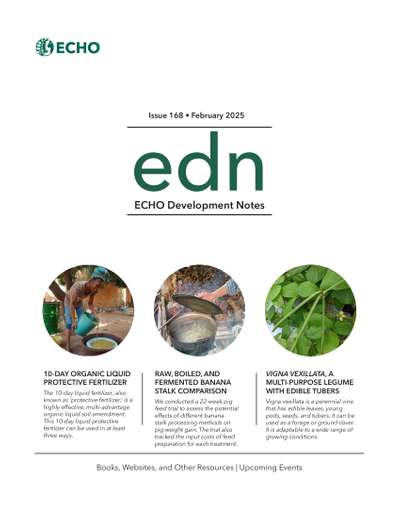
10-Day Organic Liquid Protective Fertilizer
Raw, Boiled, and Fermented Banana Stalk Comparison for use in Farm-generated Pig Feed
Grey Water for Watering Plants
From ECHO’s Seed Bank: Vigna vexillata, A Multi-Purpose Legume with Edible Tubers
Books, Websites, and Other Resources: Invitation to Submit an Article and Underutilized Crops Symposium Speaker Highlights
Articles
10-Day Organic Liquid Protective Fertilizer
Hassan Djebro
The 10-day liquid fertilizer, also known as ‘protective fertilizer,’ is a highly effective, multi-advantage organic liquid soil amendment. The rapid liquid protective fertilizer is the product of the biological decomposition of a mixture of organic matter, animal excrement, sugar source, and flour. This natural amendment is obtained after 10 days and must be diluted before application in fields and gardens.
Vigna vexillata, A Multi-Purpose Legume with Edible Tubers
Robert Walle
Vigna vexillata is a perennial vine that has edible leaves, young pods, seeds, and tubers. It can be used as a forage or ground cover. It is adaptable to a wide range of growing conditions.
Grey Water for Watering Plants
Robert Walle
Using water from showers, sinks, and clothes washing, known as “grey water,” for watering plants is a common practice for both food and ornamental crops. Using grey water helps save potable water for other uses or provides water for plants in times of water scarcity.
Raw, Boiled, and Fermented Banana Stalk Comparison for use in Farm-generated Pig Feed
Jonathan Ribich, Kitichai Saampunsinkor, Lar Lar Chaichana, Boonsong Thansritong, and Patrick Trail
Farm-generated pig feed can be a cost-effective option for smallholder farmers, particularly in remote settings that produce wild or cultivated feed inputs (Trail et al., 2020). Farmers use farm-generated feed inputs to supplement or reduce commercial feed, lowering overall feed costs. In Northern Thailand, banana plant stalks (pseudostems) are an abundant resource and popular pig feed input for smallholder farmers. Farmers commonly process banana stalks by chopping and boiling them before mixing them with other feed for their pigs (Burnette and Pawkham, 2019).
While farmers can benefit from the accessibility and lower cost of local resources for feed, these inputs may also require more time for pigs to reach market weight (Trail et al., 2020). Extra growth time might be less of a consideration when raising pigs for breeding purposes or as a family asset. But for smallholder farmers looking to maximize profit from meat production, this can be a significant factor. Efficient feed processing and lower input costs become increasingly important with slower growth rates.